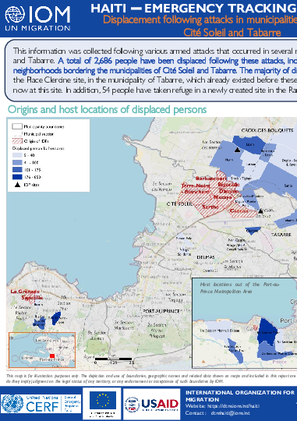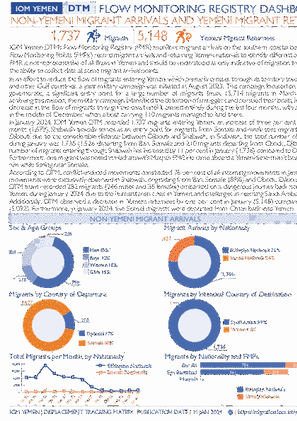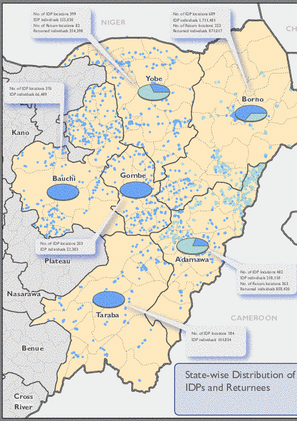-
Countries
-
Data and Analysis
-
Special Focus
-
Crisis Responses

Contact
DTM Ethiopia, DTMEthiopia@iom.int
Language
English
Location
Ethiopia
Period Covered
Nov 25 2022
Jan 08 2023
Activity
- Mobility Tracking
- Village Assessment
This snapshot report will present data on returned migrants from abroad collected by the International Organization for Migration (IOM) through its Displacement Tracking Matrix (DTM) methodology and Village Assessment Survey (VAS) tool in the Amhara and Oromia regions of Ethiopia between November 2022 and January 2023. A total of 21,832 returned migrants from abroad were identified in 730 villages in Amhara region and 4,812 returned migrants from abroad were identified in 174 villages in Oromia region.
Contact
DTMDRC@iom.int
Location
Democratic Republic of the Congo
Activity
- Mobility Tracking
- Baseline Assessment
Period Covered
Dec 19 2023 -Jan 27 2024
The ongoing conflict between the M23 rebel group and the Forces Armées de la République Démocratique du Congo (FARDC) and their allies has been a major source of violence and instability in the region. The situation has deteriorated further since the withdrawal of several East African Community (EAC) force bases from the affected territories. This conflict has not only caused the loss of human life and the displacement of millions of people but has also hampered efforts to establish peace and stability in the region. Since the beginning of the crisis, IOM, through its Displacement Tracking Matrix (DTM) has continued conducting a series of rapid assessments, including emergency monitoring (EET/ERM), crisis analysis and registration, with the aim of responding to immediate information needs in order to understand displacement dynamics. This dataset presents the results of assessments carried out in the various displacement and return areas between 19 December 2023 and 27 January 2024.
Population Groups
IDPs
Returnee (Previously Internally Displaced)
Survey Methodology
Unit of Analysis Or Observation
Admin Area 2
Admin Area 3
Admin Area 4
Type of Survey or Assessment
Key Informant
Keywords
Geographical Scope Partial Coverage
Administrative boundaries with available data
The current dataset covers the following administrative boundaries
Contact
DTM Sudan, DTMSudan@iom.int
Location
Sudan
Activity
- Mobility Tracking
- Baseline Assessment
Period Covered
Jan 26 2024 -Feb 02 2024
- DTM Sudan estimates that 6,144,363 (1,224,269 Households) were recently internally displaced.
- The IDP caseload was observed in 6,594 locations across all of Sudan’s 18 states.
- The highest proportions of IDPs were observed across South Darfur (12%), River Nile (11%), East Darfur (11%), White Nile (8%), North Darfur (8%), Northern (7%), and Sennar (7%).
- Field teams reported that the IDPs observed were originally displaced from twelve states. The majority (3,522,784 IDPs, 57%) were reportedly displaced from Khartoum state; followed by South Darfur (15%), North Darfur (8%), Aj Jazirah (7%), Central Darfur (4%), West Darfur (3%), East Darfur (1%), South Kordofan (1%), West Kordofan (<1%), North Kordofan (<1%), Sennar (<1%), and White Nile (<1%).
- IOM-DTM also reported that an estimated 1,780,295 mixed cross-border movements were made into neighbouring countries.
- This product provides brief insights into those displaced in Sudan post-15 April 2023. For more granular information on the IDP caseload and the displacement context, please see IOM-DTM's Monthly Displacement Overview (05).
A more detailed version of this dataset is available, to get access kindly click on the 'Request Access' button
Population Groups
IDPs
Survey Methodology
Unit of Analysis Or Observation
Site or Location
Type of Survey or Assessment
Key Informant
Keywords
Geographical Scope Partial Coverage
Administrative boundaries with available data
The current dataset covers the following administrative boundaries
Contact
DTM Sudan, DTMSudan@iom.int
Location
Sudan
Activity
- Mobility Tracking
- Baseline Assessment
Period Covered
Apr 15 2023 -Jan 24 2024
Key Findings
- DTM Sudan estimates that 6,092,788 Individuals (1,213,683) Households) have been recently internally displaced.
- IOM DTM also reports that an estimated 1,720,890 mixed cross-border movements have been made into neighbouring countries.
- Since 15 April 2023, 45 per cent of the IDP caseload sought refuge in the Darfur and Kordofan regions, whereas 55 per cent were observed across the Northern, Eastern, and Central states.
- The majority of the IDP caseload (67%) were seeking shelter with the host community.
- While food security remains the highest priority need, health and non-food items are also growing concerns.
A more detailed version of this dataset is available, to get access kindly click on the 'Request Access' button
Population Groups
IDPs
Survey Methodology
Unit of Analysis Or Observation
Admin Area 3
Site or Location
Type of Survey or Assessment
Key Informant
Keywords
Geographical Scope Partial Coverage
Administrative boundaries with available data
The current dataset covers the following administrative boundaries
Estimated number of IDPs and Returnees by State.

Contact
dtmhaiti@iom.int
Language
English
Location
Haiti
Period Covered
Feb 07 2024
Feb 11 2024
Activity
- Mobility Tracking
- Event Tracking
This information was collected following various armed attacks that occurred in several neighborhoods of the capital since 05 February, in the municipalities of Carrefour, Cité Soleil and Tabarre. A total of 2,686 people have been displaced following these attacks, including 1,819 following attacks in the municipality of Carrefour and 867 following those in neighborhoods bordering the municipalities of Cité Soleil and Tabarre. The majority of displaced populations (94%) took refuge with host families and 6% in two sites (100 people at the Place Clercine site, in the municipality of Tabarre, which already existed before these incidents and 380 people were already accommodated there. Thus, around 480 people are now at this site. In addition, 54 people have taken refuge in a newly created site in the Ramoth de Marin school in the municipality of Croix-Des-Bouquets).
Contact
iomyemendtm@iom.int
Location
Yemen
Activity
- Flow Monitoring Survey
- Flow Monitoring
Period Covered
Jan 01 2024 -Jan 31 2024
In January 2024, IOM Yemen DTM recorded 1,737 migrants entering Yemen, an increase of three per cent compared to last month (1,679). Shabwah typically serves as an entry point for migrants from Somalia and rarely sees migrants departing from Djibouti due to the considerable distance between Djibouti and Shabwah. In Shabwah, the total number of migrants arrived during January was 1,736 (1,526 departing from Bari, Somalia and 210 migrants departing from Obock, Djibouti). The overall number of migrants entering through Shabwah has increased by 11 per cent in January (1,736) compared to December (1,569). Furthermore, one migrant was noted in Hadramawt's Maqrah FMP. He came aboard a Yemeni fishermen's boat that had carried him while fishing near Somalia.
According to DTM, conflict-induced movements constituted 76 per cent of all incoming movements in January 2024. These movements were exclusively observed in Shabwah, originating from Bari, Somalia (89%) and Obock, Djibouti (11%). Djibouti DTM team recorded 282 migrants (246 males and 36 females) embarked on a dangerous journey back home by boat from Yemen during January 2024 due to the humanitarian crisis in Yemen and challenges in reaching Saudi Arabia.
Additionally, DTM observed a decrease in Yemeni returnees by one per cent in January (5,148) compared to December (5,092). Furthermore, in January 2024, five Somali migrants were deported from Oman back into Yemen.
Population Groups
Survey Methodology
Unit of Analysis Or Observation
Type of Survey or Assessment
Keywords
Geographical Scope
Administrative boundaries with available data
The current dataset covers the following administrative boundaries

Contact
DTM Yemen, DTMYemen@iom.int
Language
English
Location
Yemen
Period Covered
Jan 01 2024
Jan 31 2024
Activity
- Flow Monitoring
- Mobility Tracking
- Baseline Assessment
تعمل مصفوفة تتبُع النزوح الخاصة بالمنظمة الدولية للهجرة في اليمن عبر سجل مراقبة التدفق في المواقع الرئيسية التي يصل عبرها المهاجرون على الحدود الساحلية الجنوبية، و المواقع التي يعبر من خلالها اليمنيون العائدون والموجودة على الحدود الشمالية لليمن مع المملكة العربية السعودية. يُراقب الباحثون المتمركزون في نقاط رصد تدفق وصول المهاجرين والمواطنين اليمنيين العائدين من أجل التعرف على الأنماط المختلفة للهجرة وتقديم تقديرات كمية للمساهمة في تحديد عدد المهاجرين الوافدين الى البلد. لا يشمل سجل مراقبة التدفق جميع نقاط التدفق في اليمن، ولكنه يمثل مؤشراً حول اتجاهات الهجرة بالنسبة لإجمالي العدد غير المعروف للمهاجرين الوافدين إلى اليمن عبر نقاط التدفق خلال الإطار الزمني المحدد. والجدير بالذكر أن القيود المفروضة على الوصول تَحُد من القدرة على جمع البيانات في بعض نقاط وصول المهاجرين.
في محاولة للحد من تدفق المهاجرين الذين يدخلون اليمن، والذي يعبر بشكل أساسي عبر أراضيه باتجاه المملكة العربية السعودية ودول الخليج الأخرى، بدأت حملة عسكرية مشتركة في أغسطس 2023، وركزت هذه الحملة على ساحل محافظة لحج، وهي نقطة دخول مهمة لعدد كبير من المهاجرين (بحد أقصى 15,714 مهاجرًا في مارس 2023). ولتحقيق هذه المهمة، كثفت الحملة العسكرية اعتقال المهربين وملاحقة قواربهم، مما أدى إلى انخفاض تدريجي في تدفق المهاجرين عبر هذا الساحل حتى توقف تماما خلال الأشهر الأربعة الماضية، مع استثناء واحد في منتصف ديسمبر، عندما تمكن قارب يحمل 110 مهاجرين من الوصول إلى ساحل لحج.
في يناير 2024، سجلت مصفوفة تتبع النزوح التابعة للمنظمة الدولية للهجرة في اليمن دخول 1,737 مهاجرًا إلى اليمن، بزيادة قدرها ثلاثة بالمائة مقارنة بالشهر الماضي (1,679). تعتبر شبوة عادة نقطة دخول للمهاجرين من الصومال ونادرا ما تشهد مغادرة المهاجرين من جيبوتي بسبب المسافة الكبيرة بين جيبوتي وشبوة. وفي شبوة، بلغ إجمالي عدد المهاجرين الذين وصلوا خلال شهر يناير 1,736 (1,526 غادروا من باري بالصومال و210 مهاجرين غادروا من أوبوك بجيبوتي). ارتفع العدد الإجمالي للمهاجرين الذين يدخلون عبر شبوة بنسبة 11 في المائة في يناير (1,736) مقارنة بشهر ديسمبر (1,569). علاوة على ذلك، تمت ملاحظة مهاجر واحد في منطقة المقرة بحضرموت. وجاء على متن قارب صيادين يمنيين كان يحمله أثناء الصيد بالقرب من الصومال.
وفقًا لمصفوفة تتبع النزوح، شكلت الحركات الناجمة عن النزاع 76 في المائة من جميع الحركات الواردة في يناير 2024. وقد لوحظت هذه الحركات حصريًا في شبوة، قادمة من باري، الصومال (89٪) وأوبوك، جيبوتي (11٪). سجل فريق مصفوفة تتبع النزوح في جيبوتي 282 مهاجرًا (246 ذكرًا و36 أنثى) انطلقوا في رحلة خطيرة للعودة إلى وطنهم بالقارب من اليمن خلال شهر يناير 2024 بسبب الأزمة الإنسانية في اليمن وتحديات الوصول إلى المملكة العربية السعودية.
بالإضافة إلى ذلك، لاحظت مصفوفة تتبع النزوح انخفاضًا في عدد العائدين اليمنيين بنسبة واحد بالمائة في يناير (5,148) مقارنة بشهر ديسمبر (5,092). علاوة على ذلك، في يناير 2024، تم ترحيل خمسة مهاجرين صوماليين من عمان إلى اليمن.

Contact
DTM Yemen, DTMYemen@iom.int
Language
English
Location
Yemen
Period Covered
Jan 01 2024
Jan 31 2024
Activity
- Flow Monitoring
- Mobility Tracking
- Baseline Assessment
IOM Yemen DTM’s Flow Monitoring Registry (FMR) monitors migrant arrivals on the southern coastal border and Yemeni return locations on Yemen's northern border with the Kingdom of Saudi Arabia (KSA). Enumerators placed at Flow Monitoring Points (FMPs) record migrant arrivals and returning Yemeni nationals to identify different patterns of migration, and to provide quantitative estimates to help define the population of irregular migrants entering the country. FMR is not representative of all flows in Yemen and should be understood as only indicative of migration trends of the unknown total number of migrants arriving in Yemen at FMPs during the time frame indicated. Access constraints limit the ability to collect data at some migrant arrival points.
In an effort to reduce the flow of migrants entering Yemen, which primarily crosses through its territory towards Saudi Arabia and other Gulf countries, a joint military campaign was initiated in August 2023. This campaign focused on the coast of Lahj governorate, a significant entry point for a large number of migrants (max. 15,714 migrants in March 2023). Towards achieving this mission, the military campaign intensified the detention of smugglers and pursued their boats, leading to a steady decrease in the flow of migrants through this coast until it ceased entirely during the last four months, with a single exception in the middle of December, when a boat carrying 110 migrants managed to land there.
In January 2024, IOM Yemen DTM recorded 1,737 migrants entering Yemen, an increase of three per cent compared to last month (1,679). Shabwah typically serves as an entry point for migrants from Somalia and rarely sees migrants departing from Djibouti due to the considerable distance between Djibouti and Shabwah. In Shabwah, the total number of migrants arrived during January was 1,736 (1,526 departing from Bari, Somalia and 210 migrants departing from Obock, Djibouti). The overall number of migrants entering through Shabwah has increased by 11 per cent in January (1,736) compared to December (1,569). Furthermore, one migrant was noted in Hadramawt's Maqrah FMP. He came aboard a Yemeni fishermen's boat that had carried him while fishing near Somalia.
According to DTM, conflict-induced movements constituted 76 per cent of all incoming movements in January 2024. These movements were exclusively observed in Shabwah, originating from Bari, Somalia (89%) and Obock, Djibouti (11%). Djibouti DTM team recorded 282 migrants (246 males and 36 females) embarked on a dangerous journey back home by boat from Yemen during January 2024 due to the humanitarian crisis in Yemen and challenges in reaching Saudi Arabia.
Additionally, DTM observed a decrease in Yemeni returnees by one per cent in January (5,148) compared to December (5,092). Furthermore, in January 2024, five Somali migrants were deported from Oman back into Yemen.
IOM Yemen DTM’s Flow Monitoring Registry (FMR) monitors migrant arrivals on the southern coastal border and Yemeni return locations on Yemen's northern border with the Kingdom of Saudi Arabia (KSA). Enumerators placed at Flow Monitoring Points (FMPs) record migrant arrivals and returning Yemeni nationals to identify different patterns of migration, and to provide quantitative estimates to help define the population of irregular migrants entering the country. FMR is not representative of all flows in Yemen and should be understood as only indicative of migration trends of the unknown total number of migrants arriving in Yemen at FMPs during the time frame indicated. Access constraints limit the ability to collect data at some migrant arrival points.
In an effort to reduce the flow of migrants entering Yemen, which primarily crosses through its territory towards Saudi Arabia and other Gulf countries, a joint military campaign was initiated in August 2023. This campaign focused on the coast of Lahj governorate, a significant entry point for a large number of migrants (max. 15,714 migrants in March 2023). Towards achieving this mission, the military campaign intensified the detention of smugglers and pursued their boats, leading to a steady decrease in the flow of migrants through this coast until it ceased entirely during the last four months, with a single exception in the middle of December, when a boat carrying 110 migrants managed to land there.
In January 2024, IOM Yemen DTM recorded 1,737 migrants entering Yemen, an increase of three per cent compared to last month (1,679). Shabwah typically serves as an entry point for migrants from Somalia and rarely sees migrants departing from Djibouti due to the considerable distance between Djibouti and Shabwah. In Shabwah, the total number of migrants arrived during January was 1,736 (1,526 departing from Bari, Somalia and 210 migrants departing from Obock, Djibouti). The overall number of migrants entering through Shabwah has increased by 11 per cent in January (1,736) compared to December (1,569). Furthermore, one migrant was noted in Hadramawt's Maqrah FMP. He came aboard a Yemeni fishermen's boat that had carried him while fishing near Somalia.
According to DTM, conflict-induced movements constituted 76 per cent of all incoming movements in January 2024. These movements were exclusively observed in Shabwah, originating from Bari, Somalia (89%) and Obock, Djibouti (11%). Djibouti DTM team recorded 282 migrants (246 males and 36 females) embarked on a dangerous journey back home by boat from Yemen during January 2024 due to the humanitarian crisis in Yemen and challenges in reaching Saudi Arabia.
Additionally, DTM observed a decrease in Yemeni returnees by one per cent in January (5,148) compared to December (5,092). Furthermore, in January 2024, five Somali migrants were deported from Oman back into Yemen.
Contact
DTM Yemen, iomyemendtm@iom.int
Location
Yemen
Activity
- Mobility Tracking
- Event Tracking
Period Covered
Feb 04 2024 -Feb 10 2024
From 1 January to 10 February 2024, IOM Yemen DTM tracked 404 households (HH) (2,424 Individuals) who experienced displacement at least once.
Between 4 and 10 February 2024, IOM Yemen DTM tracked 19 households (114 individuals) displaced at least once. The majority of people moved into/within the following governorates and districts:
- Al Hodeidah (9 HHs) – Al Khukhah (6 HHs), Hays (3 HHs) districts. All displacements in the governorate were internal.
- Ma’rib (8 HHs) – Ma’rib City (6 HHs), Harib (1 HH), Ma’rib (1 HH) districts. Most displacements in the governorate originated from Ta’iz and Sanaa.
- Ad Dali (1 HH) – Al Azariq (1 HH) district. All displacements in the governorate originated from Sanaa City.
The majority of people moved from the following governorates and districts:
- Al Hodeidah (10 HHs) – At Tuhayta (3 HHs), Hays (3 HHs), Ad Durayhimi (2 HHs) districts.
- Ta’iz (4 HHs) – Al Makha (1 HH), At Taiziyah (1 HH1), Al Qahirah (1 HH) districts.
- Ibb (2 HHs) – Hazm Al Odayn (1 HH), Al Makhadir (1 HH) districts.
Population Groups
Survey Methodology
Unit of Analysis Or Observation
Type of Survey or Assessment
Keywords
Geographical Scope
Administrative boundaries with available data
The current dataset covers the following administrative boundaries
